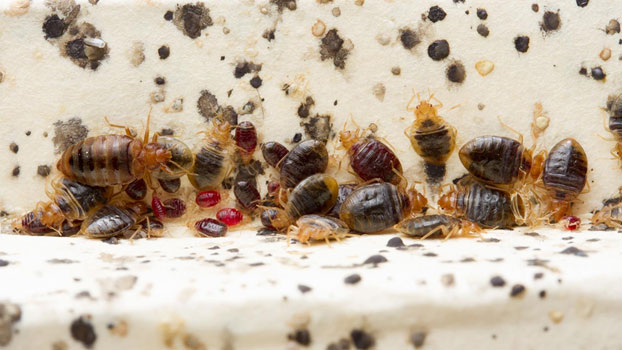A1 Bed Bug Extermination Houston: Specialist Services
A1 Bed Bug Extermination Houston: Specialist Services
Blog Article
Recognizing the Lifecycle of Pests for Targeted Control Techniques
Understanding the lifecycle of insects is an essential facet of efficient bug monitoring strategies. By understanding the numerous phases of growth that parasites undertake, an extra specific and targeted technique can be embraced to manage their populations. This expertise not just loses light on the susceptabilities within the bug lifecycle however also paves the means for carrying out calculated steps that can disrupt their development and recreation cycles. Through a much deeper understanding of exactly how insects grow and progress, tailored control techniques can be developed to deal with specific points in their lifecycle, inevitably bring about more successful pest monitoring results.
Significance of Recognizing Pest Lifecycle
Comprehending the lifecycle of pests is crucial for developing efficient and targeted control approaches in insect administration. By understanding the various stages a bug experiences from egg to adult, parasite control professionals can determine weak spots in the lifecycle where intervention can be most successful. For circumstances, knowing when larvae are most active can assist establish the optimal timing for applying larvicides. Additionally, comprehending the life-span of a parasite species can help in forecasting populace development patterns and potential invasion threats.
In addition, identifying the certain ecological conditions required for each phase of the parasite's lifecycle can lead choices on habitat modification or exclusion approaches to interfere with the lifecycle and minimize insect populations. This knowledge enables pest monitoring experts to execute proactive measures as opposed to counting exclusively on reactive treatments, leading to even more long-term and sustainable parasite control remedies. Inevitably, an extensive understanding of insect lifecycles empowers parasite control experts to customize their methods efficiently, optimizing and lessening environmental impacts control end results.
Secret Stages in Parasite Growth
To efficiently implement targeted control methods in pest administration, a crucial element hinges on comprehensively determining and recognizing the key phases in pest advancement. Bug growth generally includes numerous essential phases that are essential for their lifecycle and monitoring. The first stage is the egg phase, where bugs lay eggs that later on hatch out into larvae. Larvae after that advance right into pupae, a stage where they undergo transformation prior to becoming grown-up parasites. Understanding these stages is necessary as it aids in determining weak spots in the lifecycle where control actions can be most reliable.

Susceptabilities in Parasite Lifecycle
Throughout the numerous stages of a parasite's lifecycle, unique vulnerabilities arise that can be purposefully targeted for reliable control actions. One essential susceptability depends on the egg stage, where pests are usually extra at risk to specific insecticides or organic control agents due to their soft external shell, making them easier targets for intervention. In addition, the larval or nymph phase presents susceptabilities as insects undertake quick growth and development, requiring high power usage that can be made use of by disrupting their food resources or introducing growth preventions. Pupal stages, characterized by stability and improvement, use a window for targeted control through physical barriers or specific therapies that impede effective introduction. Grown-up pests, while extra durable due to their reproductive capability, can still be susceptible throughout mating or egg-laying tasks, which can be interfered with via scent traps or sanitation methods. Comprehending these vulnerabilities in the bug lifecycle is necessary for developing accurate and efficient control techniques that effectively handle bug populations while decreasing ecological effect.
Implementing Targeted Control Actions

Carrying out targeted control steps typically involves a multi-faceted approach. This might consist of habitat alteration to make the atmosphere less congenial to bugs, such as removing standing water for mosquito control or sealing entry factors for rats. Furthermore, organic control methods can be used, where natural predators or pathogens are presented to maintain insect populaces in check.
Chemical control, such as the mindful application of chemicals, is an additional typical strategy. Nonetheless, it is vital to make use of click these materials sensibly to decrease ecological influence and potential damage to non-target species. Integrated Bug Management (IPM) methods that combine various control steps in a coordinated and sustainable manner are commonly one of the most efficient in accomplishing long-term insect management goals. By carrying out targeted control measures based upon a comprehensive understanding of insect lifecycles, bug populations can be properly regulated while reducing risks to human health and the atmosphere.
Boosted Pest Administration Practices

Furthermore, the unification of organic control agents, such as all-natural predators or virus of pests, can help in reducing reliance on chemical pesticides and promote a more well balanced ecological community. Implementing physical barriers and traps can likewise belong to enhanced pest management techniques, using safe and targeted options for pest control. In addition, the use of pheromones and various other semiochemicals can interfere with pest breeding patterns and communication, bring about minimized insect populations gradually.
Final Thought
By recognizing vital stages in bug growth and vulnerabilities in their lifecycle, targeted control actions can be executed to minimize insect populaces. Improved bug administration techniques can assist lower the dependence on broad-spectrum pesticides and promote more eco friendly and sustainable pest control approaches.
Comprehending the lifecycle of insects is essential for creating effective and targeted control techniques in pest monitoring. By comprehending the numerous phases a parasite goes through from egg to adult, bug control professionals can determine susceptible factors in the lifecycle where intervention can be most effective. Eventually, a thorough understanding of pest lifecycles equips pest control practitioners to customize their techniques successfully, optimizing informative post and reducing ecological effects control end results.
By applying targeted control steps based on a thorough understanding of insect lifecycles, parasite populations can be successfully managed while decreasing dangers to human health and wellness and the atmosphere.
By determining essential phases in insect advancement and susceptabilities in their lifecycle, targeted control steps can be carried out to lessen bug populaces.
Report this page